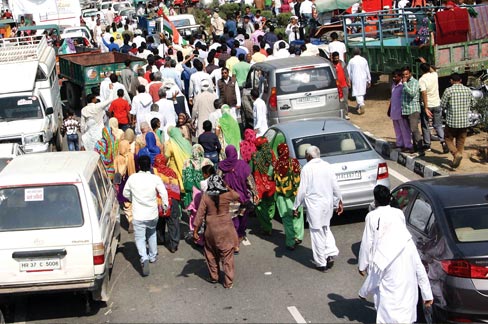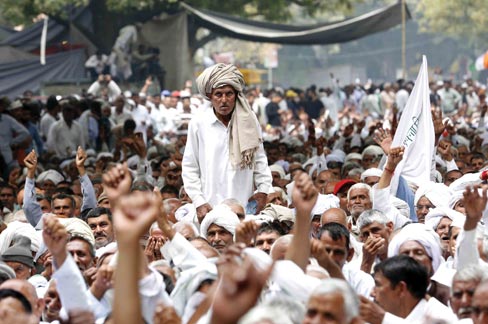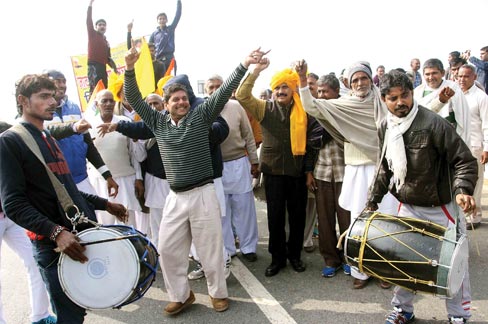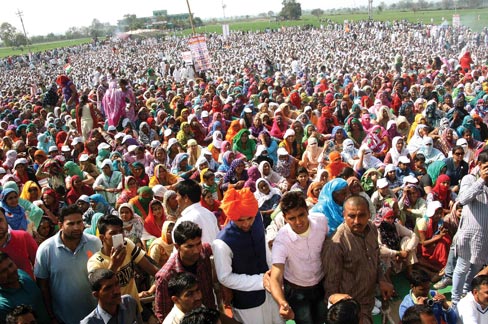THE Jats of Haryana, actively supported by their cousins across the Yamuna river in western UP, are once again up in arms, pressuring the State and central governments to grant them ‘backward status’. They had similarly agitated in February 2016 despite the Supreme Court nullifying on March 17, 2015, a notification for Jat reservation issued by the dying regime of UPA2. The Supreme Court order said, “We set aside the notification to implement the inclusion of Jats in the Central list of OBC.” The order added, “Caste, though a prominent factor, can’t be the sole factor to decide backwardness… Backwardness has to be social backwardness and not educational or economic backwardness.”
Behind the reservation demand of a progressive community like the Jats, who have earned laurels from all over the country and the world at large for producing some of the country’s finest warrior-soldiers, sports persons, scientists, writers, doctors, engineers, architects, business persons, politicians, etc., lies a heart-breaking story of mounting agrarian crisis that is fast turning farmers into peasants and landowners into wage workers. As per capita land holdings decrease among Jat farmers (and also among Gujjars, Patidars, Marathas, Kapus, etc.) and the negative rate of return on agricultural produce falls further, there is desperation for government jobs among the rural population. The general perception all over rural India, and Jats are no exception to that, is that a government job is as life-nourishing as ‘mother’s milk.’ What makes a government job doubly tempting is the clear prospect of getting kickbacks in almost every position.
The escalating agrarian crisis has sowed the seeds of fear among dominant rural castes, who do not see their future in agriculture any longer because of the better economic prospects in the city. The Economic Survey 2014-15 showed that the wages of rural India increased at a measly rate of 3.6 per cent versus the inflation rate of above 5 per cent. This is confirmed by the National Sample Survey Organisation (NSSO) which has put this figure at 3.5 per cent for the year 2012-13. In its situation assessment survey of farmers (SAS), conducted once every 10 years, the NSSO assesses major sources of income of an average Indian farmer. The latest information is available for agri-year 2012-13. The SAS 2002-03 results are also available, which we use for comparison purposes. The income of farming households is shown under four heads: cultivation of crops, farming animals, rural non-farm activities (RNF) and wages/salaries (WS).
As per capita land holdings decrease among Jat farmers and the negative rate of return on agricultural produce falls further, there is desperation for government jobs among the rural population. The general perception all over rural India, and Jats are no exception to that, is that a government job is as life-nourishing as ‘mother’s milk.’


The SAS 2012-13 counts 9 crore agricultural households in India, with each earning on an average Rs. 77,112 per annum. This was more than three times of what the rural household earned in 2002-03, that is Rs. 25,380. In real terms (using the consumer price index of agri-labourer, or the CPI-AL, as the deflator with base 2004-05), however, the average agri- household’s income increased from Rs. 26,901 p.a. in 2002-03 to Rs. 38,096 p. a. in 2012-13. The 10-year compounded annual growth rate (CAGR) of the respective incomes was 11.8 per cent in nominal terms and 3.5 per cent in real terms. This means that it took about six years for nominal incomes to double and it would take about 20 years for real incomes to double.
Clearly, this level of income generation has instilled the worst kind of fears in the hearts of farmers all over the country. Majority of Jats are occupied in farming and realise that there is little for their children in their traditional occupation. So Jats, like other farmers who have land next to big cities, are selling off their land to real estate developers and some have even become rentiers. But most Jat migrants who left their villages to try their luck in Delhi, Chandigarh, Jaipur and other cities, are disappointed by the job market. In contrast to the urban middle class, they have not received the kind of English-medium education that gives access to the service sector (especially IT) that offers opportunities. Many young Jats, who have run up debts to get some private, not-so-good education, have to fall back on unskilled jobs.
These jobs are seasonal and badly paid. In the private sector, the average daily wage of the worker was Rs. 249 in 2011-12, according to the Labour Bureau, and that of the employees at large was Rs. 388. By contrast, in the public sector, the figures were almost three times more at Rs. 679 and Rs. 945, respectively. Recently, the Seventh Pay Commission recommended an increase of the minimum monthly salary from Rs. 7,000 to Rs. 18,000.
CHRISTOPHE Jaffrelot, senior research fellow at CERI-Sciences Po/ CNRS, Paris, professor of Indian politics and sociology at King’s India Institute, London, and non-resident scholar at the Carnegie Endowment for International Peace, wrote in the Indian Express on February 23, 2016 (in the aftermath of a bloody bout of Jat agitation): “Understandably, the young Jats, Patels, Kapus, and Marathas who do not find good jobs in the private sector fall back on the government. The search for government jobs among these castes is also influenced by their particularly skewed sex ratio. Parents of girls prefer grooms with stable income—those with government jobs are often their preferred choice. With fewer girls compared to boys in these castes, there is competition in the marriage market”.

However, government jobs have shrunk. There were 19.5 million jobs in the public sector in 1992-93 when the country’s population was 839 million. While there are 1.2 billion Indians now, the number of jobs in the public sector has shrunk to 17.6 million. In States that have aggressively implemented the liberalisation policy, government jobs have almost disappeared. For instance, the government’s share in employment in Gujarat is only 1.18 per cent whereas it is 16 per cent in Kerala. The decline in the number of public sector jobs does not mean that there is no government recruitment whatsoever. For instance, some vacancies are created when people retire every year and their numbers are replaced.
According to the Seventh Pay Commission report, there were 857,000 recruitments in various departments and ministries of the central government between 2006 and 2014. This gives us a figure of slightly more than 100,000 jobs being added every year. It should be noted these are only central government jobs. Assuming the same hiring rates for State governments—whose stock of jobs was 1.6 times that of the Centre’s—the total addition to overall government jobs would be less than 300,000 a year. And it’s these jobs that Jat agitation leaders are targeting.

However, even if the Jat community is given a share in this pie, only a few of them will succeed in the rat race for government jobs. The larger community may find itself exactly where it is now unless the community and its leaders invest in education. Once they set their heart on it, the Jats are competent enough to set up world class institutes of learning for their community members. Even in the current dire state, the community is strong and wise enough to donate land and mobilise resources for such ventures. Without better education, the Jats and other dominant farming communities are going nowhere.
LOOK at the reality: India is churning out graduates by the millions. Slowly but steadily, the number of persons with higher education entering India’s job market has been increasing.
According to the World Bank data, the share of workers with tertiary level education in India’s labour force doubled from 4.9 per cent to 9.8 per cent between 1994 and 2010. The rise in the share of graduates is evident across all caste groups as National Sample Survey (NSS) data shows. Consider this: In the two years to 2011-12, NSS data showed that the graduate population (including higher degrees) increased by around 10 million. Of this, around 50 percent, or 5 million people, were those who were classified as OBC.
Clearly, the country’s job market is extremely limited. The best educated will get the first preference in this market. In this situation, it’s too tempting not to press for a job quota, particularly when both UPA and BJP governments have shown their inclination to accommodate the Jats’ demand in this respect. In an apparent bid to accommodate the Jat community’s demand, the State enacted The Haryana Backward Classes (Reservation in Services and Admission in Educational Institutions) Act, 2016, providing reservation to members of the Jat, Ror, Bishnoi, Jat Sikh, Muila Jat/Muslim Jat and Tyagi communities in May 2016. The Act was challenged in the Punjab and Haryana High Court which stayed its implementation.
IN spite of its support to the Jat demand for reservation in government jobs, the ruling BJP has come to recognise that the movement has been hijacked by the regime’s opponents. On March 2, the CM told the assembly that agitating Jat leaders were raising new demands and shifting goalposts, thereby complicating the situation. “The State government was, therefore, facing difficulty in accepting their demands,” he added.
“Earlier, the Jat agitators had raised only seven demands; now their demands have increased to 28. They are insisting they will not hold any dialogue on the earlier demands. They are changing goalposts and this attitude could make the situation even more complicated,” Khattar said while responding to an adjournment motion moved by some members.
Even as the Haryana government braces up to deal with the agitators who have threatened to block the highways connecting the whole of North India, Khattar can’t really blame anyone. That’s because the Sangh and the BJP have been putting their mind and heart into creating a new political reality all over India’s rural heartland by co-opting dominant rural communities along with less privileged OBCs. Their objective is to fuse the AJGAR (Ahir, Jat, Gujjar, and Rajputs) concept of late Choudhary Charan Singh with Dr Rammanohar Lohia’s concept of consolidation of OBCs. So in the big Sangh picture, Jats of Haryana and western UP are put in the category of Patidars of Gujarat, Marathas of Maharashtra, Gujjars and Jats of Rajasthan, and Kapus of Andhra Pradesh. It is calculated by Sangh and BJP ideologues that the inclusion of Jats, Gujjars, Patidars, and Marathas may pave the way for broadening its rural support base. Although there is some apprehension among the existing OBCs about the inclusion of Jats and others in the reserved categories, that is being taken care of by giving them better representation in Sangh and BJP hierarchies.
While the Sangh and the BJP have been working on a long-term strategic plan, a common refrain in Haryana (where Jats constitute 25 percent of the population) is that former Chief Minister Bhupinder Singh Hooda’s Jat politics and his long-held ambition to wrest the leadership of the Jats from Om Prakash Chautala of the Indian National Lok Dal was responsible for the reservation agitation. Inderjeet Singh, State head of the CPI (M), told a newspaper: “After the 2009 Assembly election, when the Chautalas lost by a slender margin, Hooda began to woo the Jats in earnest.Everyone in Haryana knows that the Jat reservation stir of 2010 and 2011 that led to the blockage of rail tracks was supported by his politics.” Hooda, who had the distinction of defeating Devi Lal thrice from the Rohtak parliamentary constituency, established his hold in the Sonepat, Jhajjar, and Rohtak belt. But in other parts of the State, the majority of the Jat voters are still with the Chautalas.
Will the Chautalas support the Congress-inspired Jat reservation stir this time? Or sabotage it to settle the old score with the Hoodas? Even the current Jat agitation appears confined to Hooda’s strongholds of Sonepat, Jhajjar, and Rohtak.
Even as political pundits engage themselves in answering the above-cited questions, the mood in the country is turning against Jat agitations in view of their violent record. In an editorial, The Hindu observed: “The recurrence of violent protests led by relatively well-off communities demanding reservation, be it Patidars in Gujarat last year or Jats in Haryana this year, is perplexing. The Jats are a relatively prosperous land-owning community in Haryana and are regarded as being high on the “social ladder” in the region. Their political and social might is even more evident in the influence they wield in rural areas and in the leadership of the dominant political parties in the State. The National Commission for Backward Classes had in the past come out with specific reasons against the inclusion of the Jats in Haryana in the Other Backward Classes (OBCs) list. This was overruled by the Congress-led United Progressive Alliance government at the Centre through a notification in March 2014, promising a special quota for Jats over and beyond the 27 per cent reservation for OBCs in jobs and higher education. It was left to the Supreme Court in March 2015 to quash the decision of the UPA to include Jats in nine States among OBCs, stating that “caste” alone could not be the criterion for determining socio-economic backwardness. Clearly, even if the demands do not make any constitutional or legal sense, the bipartisan consensus over extending reservations has emboldened protesters among the Jat community. After all, the Bharatiya Janata Party in power too had voiced support for the implementation of the March 2014 notification.”
BUT BJP and Congress support may not be sufficient for Jat agitators to get their demand met as is reflected in the March 2015 SC verdict. Whatever tricks agitation leaders like Yashpal Mallick and others may employ, they are sure to backfire. The State and central governments may not find it convenient any longer to encourage any kind of violence by agitationtists. The blockade of highways, to which Jats have been resorting to since the days of India’s fight against foreign invaders like Mughals and the British, is a losing proposition in the new context.
Neither the State nor the central government represents alien interests. Both are creations of the social contract, under which the people of Haryana have ceded their sovereignty to State and central governments in exchange for liberty. And liberty must lead to fraternity and not dominance of one community over the other. The educated Jats are aware of this political philosophy that has gone into the making of the Indian State. So, one wouldn’t be surprised if the countervailing forces within the Jat community neutralise the impact of the ongoing agitation. It has already happened in the case of Gujarat’s Patidar agitation.





























































